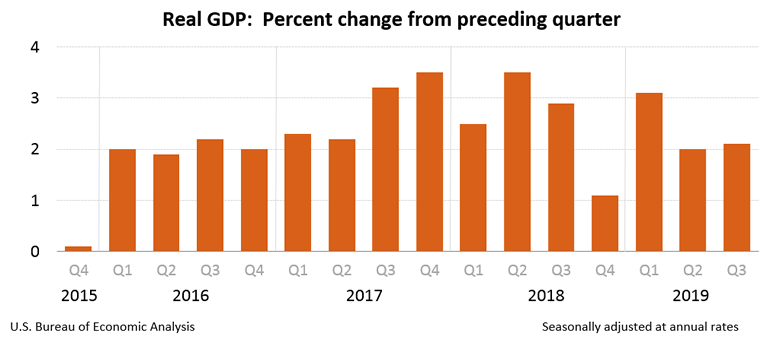
|
GDP 2.1 percent in the Third Quarter 2019. Corporate Profits Up Slightly Real gross domestic product (GDP) increased at an annual rate of 2.1 percent in the third quarter of 2019 (table 1), according to the "second" estimate released by the Bureau of Economic Analysis. In the second quarter, real GDP increased 2.0 percent. The GDP estimate released today is based on more complete source data than were available for the "advance" estimate issued last month. In the advance estimate, the increase in real GDP was 1.9 percent. With the second estimate for the third quarter, upward revisions to private inventory investment, nonresidential fixed investment, and personal consumption expenditures (PCE) were partially offset by a downward revision to state and local government spending (see "Updates to GDP" on page 2).
The increase in real GDP in the third quarter reflected positive contributions from PCE, federal government spending, residential investment, private inventory investment, exports, and state and local government spending that were partly offset by a negative contribution from nonresidential fixed investment. Imports, which are a subtraction in the calculation of GDP, increased (table 2). The acceleration in real GDP in the third quarter reflected upturns in private inventory investment, exports, and residential fixed investment that were partly offset by decelerations in PCE, federal government spending, and state and local government spending, and a larger decrease in nonresidential fixed investment. Real gross domestic income (GDI) increased 2.4 percent in the third quarter, compared with an increase of 0.9 percent (revised) in the second quarter. The average of real GDP and real GDI, a supplemental measure of U.S. economic activity that equally weights GDP and GDI, increased 2.3 percent in the third quarter, compared with an increase of 1.4 percent in the second quarter (table 1). Current dollar GDP increased 3.8 percent, or $201.8 billion, in the third quarter to a level of $21.54 trillion. In the second quarter, GDP increased 4.7 percent, or $241.4 billion. The price index for gross domestic purchases increased 1.4 percent in the third quarter, compared with an increase of 2.2 percent in the second quarter (table 4). The PCE price index increased 1.5 percent, compared with an increase of 2.4 percent. Excluding food and energy prices, the PCE price index increased 2.1 percent, compared with an increase of 1.9 percent. Updates to GDP The upward revision to the percent change in real GDP in the third quarter reflected upward revisions to private inventory investment, nonresidential fixed investment, and PCE that were partly offset by a downward revision to state and local government spending. For more information, see the Technical Note. A detailed "Key Source Data and Assumptions" file (available at 10:00 A.M. today) is posted for each release. For information on updates to GDP, see the "Additional Information" section that follows. For the second quarter of 2019, the percent change in real GDI was revised from 1.8 percent to 0.9 percent based on newly available second-quarter private wages and salaries from the Bureau of Labor Statistics Quarterly Census of Employment and Wages. Corporate Profits Profits from current production (corporate profits with inventory valuation and capital consumption adjustments) increased $4.6 billion in the third quarter, compared with an increase of $75.8 billion in the second quarter. Profits of domestic financial corporations decreased $9.8 billion in the third quarter, in contrast to an increase of $2.5 billion in the second quarter. Profits of domestic nonfinancial corporations increased $7.9 billion, compared with an increase of $34.7 billion. Rest-of-the-world profits increased $6.5 billion, compared with an increase of $38.7 billion. In the third quarter, receipts decreased $9.1 billion, and payments decreased $15.6 billion.
|
| © 2006 - 2022. All Rights Reserved. |
